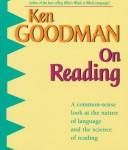Ken Goodman lays the foundation for a ‘whole language’ approach to reading.

Ken Goodman lays the foundation for a ‘whole language’ approach to reading.

As we’ve discovered, reading and writing is making sense by transacting with text, using the three systems of language simultaneously. So what is it that children must learn to do? Essentially, they must develop strategies and learn to use textual cues to make sense of text — that is, construct meaning. They can do that only by transacting with real texts in which the three systems of language relate authentically to each other. They can’t learn to control written language by focussing separately on each system. They can’t learn phonics, vocabulary and grammar in isolation because, in the real world, those systems don’t occur in isolation from language or from each other. Just as children learn to talk and listen in authentic oral language settings, they learn to read and write in authentic literacy settings. …
We build our vocabulary, in both oral and written language, through much experience with using it. There are no shortcuts that can give us the words we need before we need them. We encounter new words, or new uses of words, in our reading and listening, and then we begin to use the words ourselves. Some researchers have concluded that a large vocabulary is a prerequisite of proficient reading, but they’re wrong: vocabulary is the result of reading.
One lesson this teaches us about literacy development is that, in the transaction between reader and text, the text acts as a mediator. The author has used certain words, phrases, syntax, style, and the reader’s construction of text and meaning is mediated by the elements of the published text. When we ask readers to retell a story they’ve just read, they reconstruct the text using words, phrases and stylistic devices the text used — which isn’t surprising, since the retelling usually follows right after the reading. But it’s also true that readers often use elements from recent reading in their own speaking and writing. In other words, readers are changed by their transactions with texts: their reading /writing development is affected by the texts they are reading. That’s one more reason why developing readers need to have a diet of authentic texts in which words occur in their normal rich diversity. …
The key is that the learning is done in the context of activities in which language is necessary. It’s easy to see how kids are immersed in activities that require oral language; it took us longer to realize that in literate societies they are also immersed in written language activities, and that they learn as easily and universally from those activities. We can conclude that language is learned most easily when the focus isn’t on the language but on what we’re doing with it.
Moreover, just as we learn to talk by listening, we learn to write by reading. In each case, we become aware of the system of language by trying to make sense of it over many experiences. We invent our own systems for speaking and writing, drawing on the resources from our listening and reading. Gradually our inventions for expressing our meanings move toward the conventions of the social language, oral or written. Oral language supports written language because the two share grammar and meanings. We build written language with all of the oral language resources. Receptive processes support productive ones, and vice versa.
Goodman, Kenneth S. 1996. On Reading. Portsmouth, NH: Heinemann. pp. 118-125. || Amazon || WorldCat